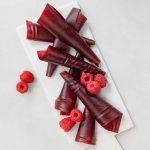Fruit Roll Ups
Homemade fruit leather and fruit roll-ups are a fun, fruity snack made entirely from fruit. It’s a highly upgraded version of the processed fruit leather roll-ups you may have enjoyed from the store as a kid. No sugar added, and no boiling needed.
Servings: 20 strips
Calories: 9kcal
Instructions
- Blend the fruit. Add the fruit to a high-speed blender and blend on high until completely smooth.
- Strain the fruit purée (optional). If you're blending fruit with a lot of seeds, such as raspberries or blackberries, use a fine mesh strainer to strain it. If you don't mind the seeds and want to keep them for extra fiber, you can skip this step.
- Spread the fruit mixture. Pour 1 cup/240 ml of the fruit mixture on a dehydrator sheet* into a ⅛-inch/0.3-cm thin layer. You can tilt the tray and/or use an offset spatula to make the layer as even as possible. You can spread the fruit mixture into a thicker ¼-inch/0.6-cm layer, but that's best for fruit strips rather than rolls. Also, a silicone mat works better than parchment paper if you don't own dehydrator sheets. The fruit purée is quite runny, which causes the parchment paper underneath to crease and makes the fruit leather crinkly and uneven in places. Do not use foil—the fruit leather will stick!
- Dehydrate. Set the dehydrator to 140ºF/60ºC and allow the fruit leather to set and dry, for 7-12 hours. You can test if the fruit leather is done by touching the center. It should feel dry or very subtly tacky, but not sticky, and it should be pliable. Be careful not to overdry it, or it will become crispy and won't roll. If the edges look like they’re getting crispy, you can cut those off later or brush them with a little water or juice during the baking process to rehydrate.
- Bake (if not using a dehydrator). The most economical way to make homemade fruit leather or fruit roll-ups is to use a dehydrator. If you don't own a dehydrator, set your oven to the lowest temperature possible - some ovens even come with a dehydrator setting. Temperatures between 135-150ºF/57-65ºC are ideal, though up to 170-180ºF/75-80ºC will work too. Avoid any temperatures above 200ºF/95ºC, though. The time to make fruit leather in the oven will vary based on the temperature and how thick your fruit puree is on the tray. As a general guideline, expect it to take between 8-12 hours at 140ºF/60ºC, 5-8 hours at 150ºF/65ºC, and 3-5 hours at 170ºF/75ºC. If the oven doesn't go low enough, crack open the oven door and use a thermometer to help you gauge the temperature of the oven. Check the thermometer every 15 minutes to ensure you're close to the ideal drying temperature.
- Cool. Once dry, remove the fruit leather from the dehydrator/oven and allow it to cool to room temperature. Then, peel it off the sheet and cut it into squares or long strips.
- Store. Leftover fruit leather keeps well in an airtight container in a cool, ideally between 65-70°F/18.3-21.1°C, dry, dark place away from direct sunlight, moisture, and strong scents for up to 2 weeks. For longer-term storage, refrigerate in an airtight container for up to 1 month of freeze for up to 6 months.
Notes
*3 cups/375 g of raspberries yields ~ 1 cup/240 ml of raspberry purée.
**Nutrition information is approximate and may contain errors. Please feel free to make your own calculations.
Nutrition
Serving: 1of 20 | Calories: 9kcal | Carbohydrates: 2g | Protein: 0.2g | Fat: 0g | Fiber: 1g | Sugar: 0.8g
